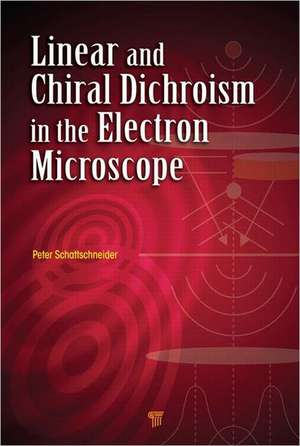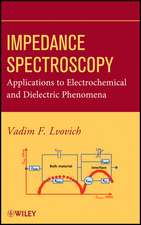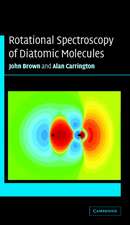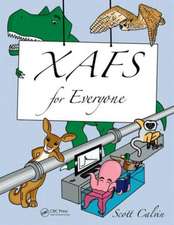Linear and Chiral Dichroism in the Electron Microscope
Editat de Peter Schattschneideren Limba Engleză Hardback – mar 2012
Preț: 895.29 lei
Preț vechi: 1091.82 lei
-18% Nou
Puncte Express: 1343
Preț estimativ în valută:
171.31€ • 178.86$ • 141.78£
171.31€ • 178.86$ • 141.78£
Carte tipărită la comandă
Livrare economică 05-19 aprilie
Preluare comenzi: 021 569.72.76
Specificații
ISBN-13: 9789814267489
ISBN-10: 9814267481
Pagini: 278
Ilustrații: 126 b/w images
Dimensiuni: 152 x 229 x 23 mm
Greutate: 0.57 kg
Ediția:1
Editura: Jenny Stanford Publishing
Colecția Jenny Stanford Publishing
ISBN-10: 9814267481
Pagini: 278
Ilustrații: 126 b/w images
Dimensiuni: 152 x 229 x 23 mm
Greutate: 0.57 kg
Ediția:1
Editura: Jenny Stanford Publishing
Colecția Jenny Stanford Publishing
Public țintă
Academic and PostgraduateCuprins
Basic Concepts: Momentum Resolved ELNES. Relativistic Effects and the Magic Angle. An Introduction to XMCD. Chirality in EELS and the Role of the Angular Momentum. Calculation Methods: Multiplet Methods. DFT Methods. Multiple-Scattering Theory of Circular Dichroism. Experimental Chiral/Circular Dichroism: EMCD Techniques and Geometries. Data Treatment, Artefacts, Noise. The Role of the Crystal. Sum Rules in EMCD and XMCD. Related Techniques and Perspectives: Magnetic Dichroism in X-Ray Holography. Prospects for Spin Mapping with Atomic Resolution.
Notă biografică
Peter Schattschneider studied physics at the Vienna University of Technology, Austria, and finished in 1973 with a diploma thesis on diffusion profiles in thin films. In 1974, he enrolled in the study of college teacher for physics and mathematics at the University of Vienna and obtained a mag. rer. nat. degree in 1977. After his PhD thesis on X-ray diffraction of binary alloys, he left Vienna University of Technology in 1976 and came back in 1980 as assistant at the Institute for Applied and Technical Physics. In the meantime, he worked in an engineering enterprise, dealing with remote sensing (air- and spaceborne sensors). In 1981, he obtained the Theodor-Körner award for work on the EEL spectrometer installed at the old ELMISKOP IA. In 1988, he became assistant professor at the Institute for Applied and Technical Physics of the Vienna University of Technology, where his main research interests were electron microscopy, inelastic electron–matter interactions, and electron energy-loss spectrometry. In 1992 and 1993, he was employed by the CNRS (Centre Nationale de la Recherche Scientifique) in Paris. Since 1995, he has been professeur invité at the École Centrale Paris. From January 2000 to June 2006, he was head of the University Service Center for Transmission Electron Microscopy (USTEM).
Recenzii
"This nice book provides a very useful approach of a recently developed technique, electron energy loss magnetic chiral dichroism (EMCD), available in transmission electron microscopy to detect if your sample presents anisotropic or magnetic effects (linear dichroism and chirality). The comparison with a previous X-Ray technique known as XMCD (X-ray magnetic circular dichroism), and this EMCD is clearly and usefully exposed. Advantages and disadvantages of both methods are discussed, spatial resolution also. With EMCD, atomic resolution can be hoped with new aberration corrected microscopes. Experimental situations in both cases are very understandably described and also the theory (necessity of the density matrix formulation, mixed dynamical form factor-MDFF) which is taken from the beginning. The figures are also very explicative. A very interesting book for students and searchers."
—"Prof. Bernard Jouffrey, École Centrale Paris, France
"This book covers the exciting new area of characterization of materials on the nanoscale by studying the chirality of electrons in transmission electron microscopy (TEM). Schattschneider, his team in Vienna and his colleagues all around the world, edited an extremely well written book which will have its impact for the important area of advanced characterisation techniques of materials with high spatial resolution- nearly on the atomic scale. The different techniques can be used by experienced microscopists who are able to understand the physics of the different inelastic scattering processes occurring in a specimen in TEM."
—Prof. Manfred Rühle, MPI for Intelligent Systems, Germany
"This state-of-the-art textbook describes how magnetic properties of solids can be investigated by using x-ray absorption and electron energy-loss spectroscopy. The main emphasis is on the underlying theory but experimental techniques, data analysis and recent results are also well covered. Chiral effects in anisotropic materials, multiplet and density-functional theory, magic-angle and relativistic effects, x-ray holography and the possibility of atomic-scale spin mapping are all described in detail by experts in these various fields."
—Prof. Ray Egerton, University of Alberta, Canada
Peter Schattchneider has made many fundamental contributions to the theory of electron-beam imaging and spectroscopic techniques. In this book he reviews the promising new method of dichroism induced, not by light, but by the electron beam of a modern transmission electron microscope, and detected using the energy-loss spectrum. The result is a spin-sensitive imaging method with far higher spatial resolution than similar synchrotron-based methods.
—Prof. John Spence - Arizona State University, USA
—"Prof. Bernard Jouffrey, École Centrale Paris, France
"This book covers the exciting new area of characterization of materials on the nanoscale by studying the chirality of electrons in transmission electron microscopy (TEM). Schattschneider, his team in Vienna and his colleagues all around the world, edited an extremely well written book which will have its impact for the important area of advanced characterisation techniques of materials with high spatial resolution- nearly on the atomic scale. The different techniques can be used by experienced microscopists who are able to understand the physics of the different inelastic scattering processes occurring in a specimen in TEM."
—Prof. Manfred Rühle, MPI for Intelligent Systems, Germany
"This state-of-the-art textbook describes how magnetic properties of solids can be investigated by using x-ray absorption and electron energy-loss spectroscopy. The main emphasis is on the underlying theory but experimental techniques, data analysis and recent results are also well covered. Chiral effects in anisotropic materials, multiplet and density-functional theory, magic-angle and relativistic effects, x-ray holography and the possibility of atomic-scale spin mapping are all described in detail by experts in these various fields."
—Prof. Ray Egerton, University of Alberta, Canada
Peter Schattchneider has made many fundamental contributions to the theory of electron-beam imaging and spectroscopic techniques. In this book he reviews the promising new method of dichroism induced, not by light, but by the electron beam of a modern transmission electron microscope, and detected using the energy-loss spectrum. The result is a spin-sensitive imaging method with far higher spatial resolution than similar synchrotron-based methods.
—Prof. John Spence - Arizona State University, USA
Descriere
This book describes energy loss magnetic chiral dichroism (EMCD), a phenomenon in energy loss spectroscopy discovered in 2006. EMCD is the equivalent of XMCD but is based on fast probe electrons in the electron microscope. A spatial resolution of 2 nm has been demonstrated, and the lattice-resolved mapping of atomic spins appears feasible. EMCD is, thus, a promising technique for magnetic studies on the nanometer and sub-nanometer scale, providing the technical and logistic advantages of electron microscopy, such as in situ chemical and structural information, easy access, and low cost.











